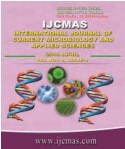


 National Academy of Agricultural Sciences (NAAS)
National Academy of Agricultural Sciences (NAAS)

|
PRINT ISSN : 2319-7692
Online ISSN : 2319-7706 Issues : 12 per year Publisher : Excellent Publishers Email : editorijcmas@gmail.com / submit@ijcmas.com Editor-in-chief: Dr.M.Prakash Index Copernicus ICV 2018: 95.39 NAAS RATING 2020: 5.38 |
Trichoderma can produce secondary metabolites which act as anti-bacteriawhichpotential to be used for controlling the plant pathogen like Xanthomonas axanopodis pv. alii. The purpose of this study was to known the best interaction beetween the filtrates of Trichoderma spp and cocentration of the filtrate for reducing the growth of X. axanopodis pv. alii caused leaf blight disease on red onion. The method of secondary metabolite production of Trichoderma spp was the single culture. The design used was factorial in a complete randomized design with 2 factors and 4 replications. The first factor was the filtrate originating from Trichoderma spp, i.e. T. harzianum, T. koningii and T. viride and the second factor was the concentration of Trichoderma spp, i.e. 0%, 25%, 50%, 75% and 100%. Parameters observed were: wide of clear zone, the amount of colony and the growth rate of of X. axanopodis. The result show that all Trichoderma filtrate can inhibit the growth of X. axanopodis pv. alii. The higher of concentration the more depressed the pathogen growth. The interaction between the filtrate and the concentration indicated that the filtrate of T. harzianum with a concentration of 100% could inhibit the total growth of X. axanopodis pv. alii.
 |
 |
 |
 |
 |